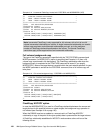
108 IBM System Storage DS6000 Series: Copy Services with IBM System z
As shown in Example 9-20, Fast Reverse Restore is invoked with the FCESTABL command
and the ACTION(FRR) param
eter.
Example 9-20 FlashCopy Fast Reverse Restore function
//********************************************************
//* THIS JOB WILL REVERSE THE DIRECTION OF FLASHCOPY
//* ORIGINAL SOURCE = 3500, FRR SOURCE = 4500
//* ORIGINAL TARGET = 4500, FRR TARGET = 3500
//********************************************************
//STEP1 EXEC PGM=IKJEFT01,REGION=256K
//SYSTSPRT DD SYSOUT=*
//SYSUADS DD DSN=SYS1.UADS,DISP=SHR
//SYSLBC DD DSN=SYS1.BRODCAST,DISP=SHR
//SYSTSIN DD *
FCESTABL SDEVN(X'4500') TDEVN(X'3500') ACTION(FRR)
/*
In Example 9-20, we reversed the FlashCopy direction for the previously established
FlashCopy relationship between volume 3500 (source) and 4500 (target), by specifying 4500
as a source volume and 3500 as a target volume.
Revert is a function to be used with Global Mirror for DS6000 when recovering from an
outage. It specifies a rollback to the state saved by a previous automatic FlashCopy establish
command. Revert is a function that is invoked with the FCWITHDR command and the
ACTION(REVERT) parameter. The FlashCopy relationship is not removed (withdrawn) but
the FlashCopy target is rolled back to the previous consistency group created by the Global
Mirror session. For more information, refer to 23.7.4, “Check for valid Consistency Group
state” on page 285.
Withdraw FlashCopy relationships
TSO FCWITHDR is used to remove existing FlashCopy relationships. The FlashCopy
withdraw process locates source tracks on the source device and target tracks on the target
device, and ends the FlashCopy relationship between them.
This command can be used on FlashCopy relationships whether or not a background copy is
in progress. The FCWITHDR command provides a method of manually withdrawing the
relationship.
The following examples show different options used to terminate FlashCopy relationships.
In Example 9-21 on page 109, specification of the TDEVN parameter without the SDEVN
parameter allows you to withdraw all FlashCopy relationships that have target extents on the
specified TDEVN, regardless of what source volumes are involved in those FlashCopy
relationships. In this case, the withdraw processing identifies where the source tracks are
(volume and track location) and removes all information about the relationships from all
devices involved.
Note: When a FlashCopy NOCOPY relationship is ended, the track data on the target
device is unpredictable and should not be used. Also consider that tracks may be copied
from the source to the target volume even if the source track is not changed. This includes
the track that contains the volume label. Therefore, to avoid duplicate volume serial
problems when the target device is later varied online, we recommend that you relabel the
target volume after withdrawing a volume-level FlashCopy NOCOPY relationship.


















